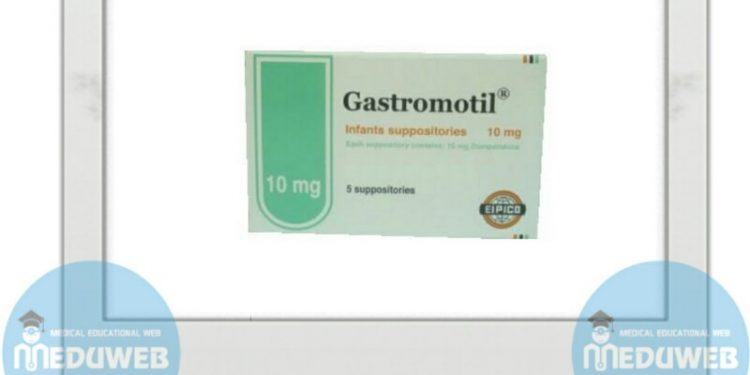Gastromotil composition:
Each dosage unit contains: F.C. Tablet Suspension (5ml) Suppository
Domperidone 10 mg 5mg 10,30,60 mg
Gastromotil excipients:
F.C. Tablets: Lactose monohydrate, cellulose, pre-gelatinized starch, hydrogenated castor oil, maize starch, povidone k 25, sodium lauryl sulphate, magnesium stearate, hydroxypropyl methylcellulose, titanium dioxide, polyethylene glycol 6000, polyethyiene glycol 35000.
Suspension: Microcrystalline cellulose, sorbitol 70% solution, methyl paraben,
propylparaben, polysorbate 80, sodium hydroxide, purified water.
Suppositories: Hard fat, butylated hydroxyanlsole, tartaric acid, aerosol 200, polysorbate 80, purified water.

Gastromotil properties:
Gastromotil® (domperidone) is a dopamine antagonist, which has both prokinetic and antiemetic properties. It selectively blocks peripheral dopamine receptors in the
gastrointestinal wall, thus enhancing normal synchronized gastrointestinal peristalsis and motility In the proximal portion of the gastrointestinal tract without affecting gastric, biliary or pancreatic secretion. Also, the resulting tone of the gastro-oesophageal sphincter Is increased and the pyloric sphincter is relaxed. Gastromotil antiemetic action is due to its direct blocking effect on dopamine receptors in the chemoreceptor trigger zone. It does not cross the blood-brain barrier to any appreciable degree and so exerts relatively little effect on cerebral dopaminergic receptors.
Gastromotil pharmacokinetics:
Domperidone is repidly absorbed from the gastrointestinal tract with alow bioavailability of about 15 % in fasting subjects although it is increased when domperidone is given after food. The low bioavallablllty Is due to first-pass metabolism. The bioavailability of rectal domperidone Is similar to that after oral doses, although peak plasma concentrations are achieved after about 1 hour for rectal dose, compared with 30 minutes after oral doses. About 90% of domperidone is bound to plasma proteins and has a terminal elimination half-life of about 7.5 hours. Domperidone is chiefly cleared from the body by extensive metabolism. About 30% of an oral dose is excreted in urine within 24 hours, almost entirely as metabolites, the remainder of a dose is excreted in the faeces over several days, about 10% as unchanged drug. It does not readily cross the blood-brain barrier. Small amounts of domperidone are distributed into breast milk.
Gastromotil indications:
-The dyspeptic symptom complex that is often associated with delayed gastric emptying, gastro-oesophageal reflux and oesophagitis:
-Epigastric sense of fullness, early satiety, feeling of abdominal distension, upper
abdominal pain.
-Bloating, eructation, flatulence.
-Nausea and vomiting.
-Heartburn with or without regurgitations of gastric contents in the mouth.
-Nausea and vomiting of functional, organic, infectious or dietetic origin or Induced by radiotherapy or drug therapy. A specific indication is nausea and vomiting induced by dopamine agonists, as used in parkinson’s disease (such as L-dopa and bromocrtpnne)
-lt is given with paracetamol in the symptomatic treatment of migraine.
Gastromotil dosage and administration:
I-Chronic dyspepsia (mainly oral administration):
Adults: 10 mg (1 tablet or 10 ml) 3 times daily, 15-30 minutes before meals and, if
necessary, once more before retiring.
Children: Oral suspension: 2.5 ml per 10 kg body weight, 3 times daily before meals and, if necessary, once more in the evening. When results are not satisfactory, the above dosage may be doubled in adults and in children over 1 year of age.
2- Acute and Subacute conditions (particularly nausea and vomiting):
Adults: Oral: 20 mg (2 tablets or 20 ml) 3 – 4 times daily before meals and before bedtime.
Rectal: 2 to 4 suppositories (60 mg) daily.
Children: Oral: 5 ml per 10 kg body weight, 3-4 times daily before meals and before
bedtime
Rectal: Up to 2 years: 1 suppository (10 mg) 2-4 times dally.
2-4 years: 1 suppository (30 mg) twice dally.
4-6 years: 1 suppository (30 mg) 3 times dally.
Older than 6 years: 1 suppository (30 mg) 4 times daily.
3- Migraine: A dose of 20 mg by mouth may be taken up 10 every 4 hours, with paracetamol. as required up 10 a maximum of 4 doses in 24 hours.
Gastromotil precautions:
– Gastromotil: is not recommended for chronic nausea and vomiting or for the routine prophylaxis of postoperative nausea and vomiting.
– Castromotil: should be used cautiously in patients with hepatic or renal impairment.
– Use In infants: Because the metabolic and blood-brain barrier functions are not fully developed during the first months of life, any drug should only be given to infants with great caution and under close medical supervision. Since the typical absence of neurological side effects with Gastromotil@ is due to its poor penetration through the blood-brain barrier, the possible occurrence of such effects cannot be totally excluded in infants under 1 year of age.
Gastromotil pregnancy and lactation:
Gastromotil should only be used during the first trimester of pregnancy if this is justified by the anticipated therapeutic benefit up till, now there has been no evidence of any increase In the risk of malformations in humans. Domperidone concentrations In breast milk are 4 times lower than corresponding plasma concentrations. It is not known whether this is harmful to the newborn. Therefore nursing is not recommended for mothers who are taking Gastromotil, unless the expected benefits outweigh any potential risk.
Gastromotil Drug interactions:
– Anti-muscarinics and opioid analgesics may antagonize the prokinetic effects of
Gastromotil.
– Ketoconazole increases the plasma concentrations of Castromotil.
– Gastromotil may antagonize the hypoprolactinaemic effect of drugs such as
bromocriptine.
Gastromotil contraindications:
– Hypersensitivity to the product.
– When stimulation of gastric motility might be dangerous as in gastroinlestinal
haemorrhage, mechanical obstruction, perforation or immediately after surgery.
– Patients with prolactin-releasing pitutary tumour (prolactinoma)
Gastromotil side effects:
– Gastromotil does not readily cross the blood-brain barrier and rarely produces central effects such as extrapyramidal reactions or drowsiness but there has been a few reports of dystonic reactions.
– Plasma – prolactin levels may be increased which may lead to galactorrhoea or
gynaecomastia.
– Allergic reactions such as rash and urticaria and transient abdominal cramps have been reported
Storage:
Tablets: Store at temperature not exceeding 30 C.
Suspension: Store at temperature nor exceeding 10 C.
Suppositories: Store at ternperature 2°·8°C.
How supplied:
Gastromotil film coated tablets: Blisters of 10 tablets each.
Gastromotil suspension: Bottles of 200 ml.
Gastromotil adult, children, infant suppositories: Box of 5 suppositories.
Produced by :
EGYPTIAN INT. PHARMACEUTICAL INDUSTRIES CO.
E.I. P.I. CO.
lOth OF RAMADAN CITY • INDUSTRIAL AREA ar, P.O. BOX: 149 TENTH, EGYPT


